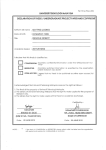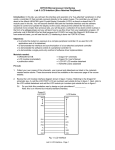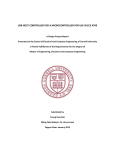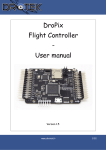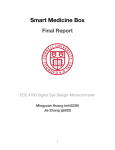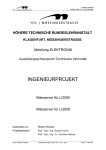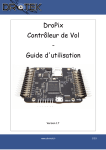Download Final Report - Machine Intelligence Lab
Transcript
Date: 4/20/2009
Student Name: Amer Qouneh
TAs : Mike Pridgen
Thomas Vermeer
Instructors: Dr. A. Antonio Arroyo
Dr. Eric M. Schwartz
University of Florida
Department of Electrical and Computer Engineering
EEL 5666
Intelligent Machines Design Laboratory
Gossima
Final Report
Table of Contents
Abstract
3
Executive Summary
3
Introduction
4
Integrated System
4
Mobile Platform
6
Actuation
6
Sensors
7
Behaviors
10
Experimental Layout and Results
10
Conclusion
11
Documentation
11
Appendices
12
2
Abstract
“Gossima” was one of the original names given for the current game of ping-pong.
Gossima continues to live on, and takes on the personality of an autonomous ping-pong
ball-collecting robot. It certainly is not fun to interrupt a game when balls run out.
Gossima is designed to help players play continuously without having to interrupt the
game to collect the balls. Equipped with a CMU camera, ultrasonic sensor, infrared
sensors, and servos, Gossima will be able to search for, retrieve, and shoot ping-pong
balls while avoiding obstacles. Some difficulties were faced when approaching a ball, as
tracking the color at close distances was not always successful.
Executive Summary
Gossima’s task is to search for, find, track, capture, and shoot ping-pong balls. It
possesses behaviors that allow it to carry out its tasks. The search behavior allows it to
find orange ping-pong balls, the acquiring behavior allows capturing and shooting a ball.
The last behavior allows avoiding obstacles.
Gossima depends on a CMU camera to find an orange-colored ball. The camera allows
the robot to track the blob of color as it moves and approaches its target. To that end, it
also uses an ultrasonic sensor that provides range information for faster detection of balls
and objects. The CMU camera provides relatively accurate color and position information
for the robot but that information is somewhat slow. The ultrasonic sensor provides faster
position information but somewhat inaccurate because of its wide beam. The ultrasonic
sensor first quickly detects the presence and direction of an object, and then the camera is
employed to determine if that object is an orange ball or just an obstacle. Combining the
strengths of both sensors allows faster initial detection of balls.
Infrared sensors along with the ultrasonic sensor provide the robot with obstacle
avoidance capability. Two infrared sensors placed on the front sides of the robot detect
the presence of any close objects. Based on this information, the robot turns to avoid the
obstacle. Bump switches also help in avoiding obstacles that bump the robot from the
back when backing up.
Gossima can capture a ball by lowering a cylinder in front of the ball and a scoop door
pushes the ball inside, thereby securing it. Once a ball is captured, the cylinder is raised
vertically and the ball falls into a shooting position. The shooter is quite simple consisting
of a small flexible piece of plastic that is pulled back by a small servo just like a
slingshot. Upon the release of the hammer, the plastic piece hits the ball and shoots out of
the robot body.
3
Introduction
Interrupting a game of ping-pong to collect the balls is not fun. A robot that can collect
the balls and relieve the players of the chore would be fun and amusing to watch. The
robot is able to avoid obstacles, find the balls and retrieve them. This robot is named
Gossima after the old name of the current ping-pong game.
To find ping-pong balls, a robot must be able to see the ball and distinguish it from the
other objects. Gossima uses a CMU camera for eyes and it determines if the objects are
balls or not. This type of camera has been successfully used in robotics and is simple to
use. However, I think it is a bit slow for tracking colors while a robot is moving.
The robot has infrared sensors that help it to avoid obstacles. An ultrasonic sensor takes a
dual role of obstacle avoidance and ball detection. With theses capabilities, a robot is able
to navigate its way and find a ball to capture it.
Gossima is built out of a simple wooden platform with the different parts attached to its
surface. It employs a cylinder to capture balls and a small slingshot-like mechanism to
shoot balls.
Integrated System
Gossima relies on its electronic and mechanical capabilities to perform its duties. An
Atmel microcontroller will orchestrate all of its functions by using its CMU camera,
bump switches, IR, and ultrasonic sensors. Mechanically, the robot will control a set of 6
servos to move itself forward, backward, and to make turns. In addition, the robot will
control a cylinder that captures a ball and loads it to a shooter. A battery of suitable
power will be used and all of the above components will reside on a wooden platform.
An Atmel Atmega128 microcontroller board with I/O ports and pins will act as the
controller for the robot. I programmed the microcontroller using the language C that will
make it much easier than writing code in assembly language. I used the PVR board,
which is a microcontroller board that is based on the ATMEL Atmega128
microcontroller. The board is equipped with an excellent selection of peripherals that will
help in controlling the robot. I used the serial port (RS 232) to communicate with CMU
camera, the six servo ports to control the servos (six of them), and the Analog to Digital
ports (A/D) to read the values returned by the ultrasonic sensor, and the two infrared
sensors.
Three bump switches (tactile) placed on the backside of the robot will detect obstacles on
impact. The switches are connected to I/O ports through pull-up resistors. These will give
the robot sensory information when it is backing up and hitting an obstacle. Two IR
sensors placed in the front will provide Gossima with the ability to avoid obstacles once
they are about six inches from the robot. The robot will turn to the opposite direction if an
obstacle is detected.
4
A CMU camera is placed at the front of the robot. It will allow the robot to find the pingpong balls that are distinguished by color (orange). The camera is controlled by a servo
that will allow it to tilt in the vertical plane to search for balls from near to far. Using the
camera, the robot detects the approximate location of the ball using an XY coordinate
system. Based on the coordinates, the robot determines in what direction to move.
An ultrasonic sensor in the front will provide the robot with the ability to act as a ranger
for detecting the balls, thereby helping the camera in its search effort. I found that the
CMU camera is relatively slow in detecting the presence of balls, however, the ultrasonic
sensor was much faster in determining the general direction of the ball. The ultrasonic
sensor is also used in obstacle avoidance for the front when it is not searching or tracking
a ball.
A battery pack of six NiMh rechargeable batteries act as the source of power for the
robot. I found that they were sufficient for my purposes and lasted about a half hour of
running and testing.
I used six servos for carrying out the mobility and capturing functions. Two of them were
micro servos that needed to be light. Three servos were hacked to rotate continuously,
two of them for the wheels, and one for the shooting mechanism.
The above sensors provide Gossima with the intended behaviors of roaming, searching
for balls, shooting, and avoiding obstacles. Once a ball is found, Gossima activates a
different behavior, that of acquiring the ball, by engaging an arm mechanism (cylinder).
The arm is lowered from the vertical position to the forward position, and captures the
ball by scooping it with a servo-operated door. Then Gossima exhibits a behavior that
allows it to find a bin of a particular color to shoot at. Figure shows a block diagram of
Gossima.
5
Figure 1
Mobile Platform
A simple wooden platform serves as the body of Gossima. It is rectangular in shape and
covers a box that houses the two wheel servos. All the components are placed on the
platform except the battery pack, which is placed on a v-shaped piece of wood attached to
the box to give a further support for the robot. A caster ball supports the back end of the
body. The platform also has a cylinder (capturing arm) that is lowered when needed. The
cylinder feeds the shooting mechanism (a flexible piece of plastic). A picture of the robot
is provided.
I learned that working with wood is difficult in the long run. It is certainly faster and
simpler to use wood for a platform, but as more adjustments are made to the platform, the
more difficult it becomes to work with. Wood screws do not stay firm in place, which
results in components falling off. A metal frame might be a better choice for a robot.
Also, it might be a good idea to build a metal platform that can be used for different
projects with little modification.
Actuation
The robot uses six servos for controlling the operation of the robot. Two hacked servos
for the wheels, one hacked micro servo for the shooting mechanism, one for the cylinder,
one for the scoop door, and one for the camera base. All six servos are attached to the six
servo ports on the PVR board. The ports provided the necessary PWM signals to the
servos. Controlling the servos was simple. However, two days before demo day, three
ports stopped working. All efforts to fix the problem had failed. Thomas Vermeer, one of
6
the TAs with the help of fellow students Jared Bevis and Joshua Childs, replaced the
Atmega chip on the PVR board, but the problem persisted through demo day preventing
the robot from performing capturing and shooting the balls.
Using servos as wheels is simple after performing the necessary modifications. Sending a
large or a small value can control speed. Sending a positive or a negative value can also
control direction of rotation. However, servos are slow as wheels, but acceptable for the
purposes I am using them for. The other three servos were not hacked and were used to
move within a certain range. One servo controlled the movement of the cylinder from the
vertical to the horizontal position. Another servo controlled the movement of the scoop
door. This servo was placed on the cylinder itself, which is why I chose it to be a micro
servo. The shooter servo was used to rotate whenever the robot wanted to shoot a ball.
When it rotates, it pulls a flexible piece of plastic (the handle of a plastic spoon),
suggested by Thomas Vermeer, and then releases it to strike a ping-pong ball. The
camera servo is used to tilt the camera forward and backward. The range of motion was
not large as the camera is not capable of detecting objects at far distances. The servo
controlled a metal wire connected to the base of the camera. If pushed forward, the
camera tilts down, if pushed back, the camera tilts up.
In general, the servos were surprisingly simple to use and my application did not require
large torques or power.
Sensors
Bump Switches
Three bump switches placed on the back are used for obstacle detection. Once a bump
switch is pressed, this indicates to the robot that it has bumped into an object. The robot
then takes a corrective action and changes its direction randomly. The switches were
connected to I/O ports through pull-up resistors. They were small tactile switches
intended for surface mounting on a PCB. I found that these are not good as bump
switches because they are so fragile. I lost the pins of two of them with normal use. Also,
the button itself was not soft enough to detect a light bump on the back of the robot.
These tactile switches needed some extra force to make a contact.
Infrared Sensors
Two Sharp IR sensors allowed the robot to detect close obstacles to its sides. Each IR
sensor was connected to an A/D port. The microcontroller read the value returned by the
sensor and took action. After testing, I determined that for the size of the robot, a distance
of about 6 to 7 inches was adequate to make a safe turn. The data sheet indicated a graph
that it was not linear; that is the values returned for the distance did not vary linearly with
the distance. After testing it myself, I did obtain a similar result. Figure 2 shows the graph
for one of the IR sensors.
7
IR Sensor 1
140
IR value
120
100
80
60
Series1
40
20
0
0
20
40
60
80
100
120
Distance (cm )
Figure 2
Ultrasonic Sensor
One ultrasonic sensor is used as simple radar for ranging. In one role, it is used in
obstacle avoidance for the front of the robot. In a second role, it is used as ranges for
detecting ping-pong balls. I found that using the ultrasonic sensor for detecting a ball is
very useful as it allows faster detection than the CMU camera. I took advantage of this
property and searched for objects using the ultrasonic sensor. After finding one, the
camera is used to decide whether it is an orange ball or not. The sensor had to be tested
for different positions. I finally placed it at the bottom close to the ground and pointing
slightly upward away from the ground. Another good place would have been at the top
looking slightly downward. I was able to detect a ball at maximum distance of about 1 m
when placed close to the ground. Figure 3 shows a graph of the returned values.
Ultrasonic Sensor
Ulrasonic value
20
15
10
5
0
0
20
40
60
80
100
120
Distance (cm )
Figure 3
8
CMU Camera
The CMU camera is used to detect a blob of color and return its pixel position through a
serial connection. The microcontroller board communicated with the camera through its
serial RS232 port. The microcontroller had to be configured to use the capability, which
was not difficult as there are many sources online about using serial ports. Use of the
camera is not difficult but did give me some hard time in the beginning. I decided to use
the poll mode, which means that the camera will send a packet of data whenever the
microcontroller asks for one. The other mode is a continuous mode, which sends packets
continuously. The camera can track a given color by specifying the RGB value for that
color. Equivalently, the camera can also acquire the color values by using the command
TW (Track Window) while placing the object in front of the camera. I used both methods
and found that telling the camera what color to look for was slightly better than asking it
to determine the color of the object.
The downside for using a CMU camera was that it required a little more time to return
data since it processes the image and then sends the data using the serial connection,
which is slow by nature. In my robot, there was a problem when tracking an orange ball.
Whenever the robot detected a ball, it would approach but would lose the ball when at
close distances because the ball would fall out of the screen. Fast movement of the robot
would cause this to happen.
In addition, I found that the CMU camera did not handle the orange color and size of the
ping-pong ball well. Since lighting is detrimental for the success of tracking, I found that
even by placing a ball in front of the camera while stationary, the camera did not even
recognize the orange ball as orange. The values returned had a low confidence value. As
explained in the camera documentation, a confidence value of greater than 50 means that
there is a high probability that it found the intended color. My camera did not return such
high confidence values. The values returned ranged from 5 to upper 40. I did use the
confidence value to determine whether that was an orange color or not. In my code I used
a testing sequence that tested the confidence value. If it were greater than 50, then it is
orange. But in practice, the robot was not able to determine it was seeing orange because
the confidence value was low. Lowering the acceptance value would cause the robot to
assume other colors and objects as orange. I think that this is the reason my robot was not
very successful at tracking the balls.
Another reason for not being able to track a ball correctly might be that the size of the
ping-pong ball is relatively small. A larger size would certainly give the camera more to
work with. The ping-pong ball appears as 1 pixel frequently, but of course much more
than that when it is close and it has a lock on it.
The color also might have played a role. The orange color is not as bright and vibrant as a
bright green or yellow for example. It might be worthwhile to use larger and brighter
balls than a small orange ball.
9
The camera itself was mounted on a small wood base that was attached to the arm of a
servo. The servo would tilt the camera forward for near objects and up for far objects. I
did not think that made a lot of difference. Many times I left it in a neutral position and
obtained similar results.
Behaviors
The robot has three behaviors: avoiding obstacles, searching for and tracking ping-pong
balls, and finally acquiring them and shooting them.
To avoid obstacles the robot depends on two Sharp IR sensors and one ultrasonic sensor.
Bump switches detect bumps on the back. Once an obstacle is found, the robot turns to
the opposite direction. If an obstacle is detected in front, then the robot makes a random
turn.
The search behavior starts with the ultrasonic sensor, as it seemed to detect objects faster
than the camera. Once the object is detected, the camera is used to determine if it is a ball
or an obstacle. If it were a ball, then the robot starts the track color sequence and
approaches the ball by correcting its path. The robot is capable of scanning an angle to
see if missed the ball on approach. The fact that the robot would lose the ball at small
distances made the task of acquiring the ball very hard. The size of the ball compared to
the cylinder is very close and hence the docking mechanism is somewhat more
demanding than if the acquiring mechanism was much larger than the ball. I learned that
in then design of robots one must give a lot of thought about how to make margins of
error more forgiving. If the mechanism that acquires a ball is much larger than the ball,
then any errors in the robot docking next to the ball would diminish and the collection of
the ball would be much easier.
The collection behavior is simple enough if the previous search was successful. The robot
goes into this mode one a ball is right in front of the robot. Then it lowers a cylinder and
opens its door. Once the ball is in front of the opening of the cylinder, a door closes down
and pushes the ball inside the cylinder. Then the cylinder is raised vertically, which
causes the ball to fall in place to be ready to by shot by the flexible plastic shooter.
Experimental Layout and Results
Since my sensors were simple enough a little testing was enough to determine how to use
them. Attached above are graphs for the infrared and ultrasonic sensors output. Based on
this data and some experiments when the sensors were mounted on the robot, I was able
to determine the suitable threshold values to use. The CMU camera testing consisted of
determining what values constitute an orange color and the margin of error that existed. I
did increase the margin of error for the CMU camera but I can’ t say the results were
much better.
10
Conclusion
Gossima is a robot that can search for, find, capture, load, and retrieve ping-pong balls. It
carries out its activities by using a microcontroller board to orchestrate its functions.
Gossima is capable of avoiding obstacles, detecting objects and determining if these
objects are orange ping-pong balls or just obstacles. Although the robot found it hard to
determine if the color in front of it was orange or not especially at very close distances, it
was able to find, track and approach a ball. Frequently, it lost tracking when it was very
close to the ball. Some of the reasons for that are the speed of approach, size of the ball,
and the color of a ball. If the approach was successful, acquiring the ball and shooting it
are very simple procedures. Important lessons to be learned are to build the platform
early on and preferably out of metal or some sturdy material; wood is not sturdy enough.
Also, when designing the robot large margins of error should be employed like using a
wide structure to acquire a small ball; that way, the robot has a very good chance in
succeeding.
Documentation
References:
CMUcam Vision Board User Manual. Anthony Rowe and Carnegie
Mellon University.
http://www.seattlerobotics.com/cmucam.htm
Pridgen Vermeer Robotics ATmega128. Revision 0
Sharp General Purpose Type Distance Measuring Sensors: GP2Y0A21YK
Ultrasonic Sensor LV-MaxSonar®-EZ2
Servos: HS-322HD Standard Deluxe
Thanks to:
Mike Pridgen
Thomas Vermeer
Jared Bevis
Joshua Childs
Joe Bari
John Kurien
Fellow students in IMDL
Kyle Tripician
11
Appendices
Code is attached in the appendix.
GossimaRobot.c
LCD.h
sleep.h
USART.h
PVR_Servos.h
ADC.h
cmuCamera.h
globalDefinitions.h
//
//
//
File Name: GossimaRobot.c
//
//
//
//
//
/*****************************************
*
*
INCLUDE FILES
*
******************************************/
#include "LCD.h"
#include "sleep.h"
#include "USART.h"
#include "PVR_Servos.h"
#include "ADC.h"
#include "cmuCamera.h"
#include "globalDefinitions.h"
/*****************************************
*
*
DEFINES
*
******************************************/
#define FALSE
0
12
#define TRUE
#define LEFT
#define RIGHT
#define FORWARD
#define BACKWARD
#define CYLINDER
#define SCOOP
1
0
1
0
1
0
1
/******************************************
*
*
PROTOTYPES
*
*******************************************/
void init_modules();
void init_camera();
void setServoPositions();
void GossimaCheckObstacles();
void GossimaCheckUltrasonic();
void SendCMUcommand();
void GossimaStop();
void GossimaMove(int direction); // moves forward or backward
void GossimaTurnRandomly();
void GossimaTurn(int direction); // turns left or right
void GossimaScanCircle();
void GossimaScanAngle();
void GossimaSearchRandomly();
void GossimaApproachBall();
void GossimaCaptureBall();
void GossimaFindBin();
void GossimaShootBall();
void GossimaSetSpeed(int speed); // sets the wanted speed
void servoSlowMove(int last_pos, int new_pos, int servoName);
to new position
// moves cylinder from last position
void GossimaLowerScoop();
void GossimaRaiseScoop();
void GossimaLowerCylinder();
void GossimaRaiseCylinder();
void GossimaDockCylinder();
void GossimaTrackColor();
void setCameraTilt(int level);
void test_ultrasonic() {
//lcdClear();
//lcdString("A/D Demo");
//lcdGoto(1,0);
13
//lcdString("Channel 1: ");
int x= 4000;
while(x>0){
lcdClear();
lcdString("Channel 2: ");
lcdGoto(1,0);
lcdInt( adcTwo() );
ms_sleep(2000);
// take 1000 samples
// start at row 1 column 0 (i.e. second line)
// display the value returned
//lcdClear();
//lcdString("looking left: ");
//lcdGoto(1,0);
//lcdInt( adcOne() );
//ms_sleep(2000);
x--;
//ms_sleep(1000);
}
}
/********************************************
*
*
GLOBAL VARIABLES
*
********************************************/
/*
*
* irdr: IR detector located on the right side of robot looking to the right.
* irdl: IR detector located on the left side of robot looking to the left.
* speedr: speed of the right servo.
* speedl: speed of the left servo.
*
* Left wheel servo:
Connected to servo 1 connector.
*
+MAX_SPEED is backward, -MAX_SPEED is
forward.
*
* Right wheel servo:
Connected to servo 2 connector.
*
-MAX_SPEED is backward, +MAX_SPEED is
forward.
*
* Camera tilt servo:
Connected to servo 3 connector.
*
Range of movement; from -100 (looking straight) to 40 (looking down)
*
* Cylinder servo :
Connected to servo 4 connector.
*
Range of movement: from -100 (lowered) to 50
(raised)
*
* Scoop servo
:
Connected to servo 5 connector.
*
Range of movement: from -120 (lowered) to 50
(raised)
*
*
* Shooter servo
:
Connected to servo 6 connector.
14
*
The servo stops by giving it a value of -48
*
*
*
*
* Right IR sensor connected to:
* Left IR sensor connected to:
* Ultrasonic sensor connected to:
*
*
*/
It seems that the zero point has shifted a lot.
int irdr = 0;
int irdl = 0;
int speedr = 0;
int speedl = 0;
int current_speed = 100;
int sonarRange = 0;
int lastSonarRange = 0;
ADC channel 0
ADC channel 1
ADC channel 2
// value of right IR sensor
// value of left IR sensor
// speed of right servo
// speed of left servo
// contains the current speed of robot
// value of ultrasonic sensor
// previous value of ultrasonic sensor
int objectDetected = FALSE;
// true of false
int ballDetected = FALSE; // true of false
int ColorDetected = FALSE;
// true of false
int ballTracked = FALSE; // true of false
int cylinderLastPos = 0;
int cylinderNewPos = 0;
int scoopLastPos = 0;
int scoopNewPos = 0;
//contains cylinders last position
//contains cylinders new position
//contains scoop last position
//contains scoop new position
u8 mmx, mmy, lcx, lcy, rcx, rcy, pix, conf, packetName;
/**********************************************
*
*
Main program
*
***********************************************/
int main(void) {
///////////////// VARIABLE DECLARATIONS //////////////////////
///////////////// INITIALIZATIONS ////////////////////////////
init_modules();
/****************************************************************
*
*
Temporarily: Left wheel is connected to servo 4
*
Right wheel is connected to servo 5
15
*
camera is connected to servo 6
*
************************************************************/
setServoPositions();
GossimaLowerCylinder();
GossimaRaiseScoop();
GossimaLowerScoop();
GossimaRaiseCylinder();
init_camera();
ms_sleep(6000);
////////////////// MAIN LOOP /////////////////////////
GossimaScanCircle();
GossimaStop();
ms_sleep(2000);
while(1) {
GossimaCheckObstacles();
if(objectDetected == TRUE) {
//GossimaStop();
//ms_sleep(2000);
GossimaTrackColor();
if(ColorDetected == TRUE) {
// then object is an orange ball, so approach ball
ballTracked = TRUE;
GossimaApproachBall();
GossimaCaptureBall();
GossimaFindBin();
GossimaShootBall();
}
else {
// it's an obstacle, so avoid
//GossimaCheckObstacles();
}
}
else {
16
lcdClear();
lcdString("search randomly");
ms_sleep(2000);
lcdClear();
GossimaSearchRandomly();
}
}// while loop
return 0;
}//end main
/*********************************************
*
*
Check if object color is what we are looking for
*
**********************************************/
void GossimaTrackColor() {
int count = 0;
SendCMUcommand();
// display an M packet
//cmuDisplay_M_packet();
if(conf < 30) {
ColorDetected = FALSE;
}//if
if(conf > 30) {
ColorDetected = TRUE;
}//if
// scan to the left first, if ball found then approach
// if ball is not found, then scan to the right
// if ball is found to the right, then approach
// else if ball is not found to the right, then search randomly
for(int j = LEFT; j < RIGHT + 1; j++) {
while(ColorDetected == FALSE && count < 2) {
GossimaTurn(j);
ms_sleep(250);
GossimaStop();
for(int i = 0; i < 2; i++) {
// for two levels of camera tilt, scan to the left
setCameraTilt(i);
SendCMUcommand();
ms_sleep(250);
// display an M packet
//cmuDisplay_M_packet();
17
if(conf < 20) {
ColorDetected = FALSE;
}//if
if(conf >= 20) {
ColorDetected = TRUE;
break;
}//if
}//for
count++;
}//while
count = 0;
if(j == 0 && ColorDetected == FALSE) {
GossimaTurn(RIGHT);
ms_sleep(400);
GossimaStop();
}
if(ColorDetected == TRUE) {
break;
}
}//for
}// end
/*********************************************
*
*
Set camera tilt level
*
**********************************************/
void setCameraTilt(int level) {
switch(level) {
case 0: moveServo6(-60);
break;
//case 1: moveServo6(-80);
//
break;
case 1: moveServo6(-95);
break;
default: moveServo6(-95);
}
}
/*********************************************
*
*
Approach balls
*
18
**********************************************/
void GossimaApproachBall() {
//
SendCMUcommand();
cmuDisplay_M_packet();
//
//
GossimaCheckUltrasonic();
ms_sleep(3);
while(pix >=1) {
SendCMUcommand();
if(conf < 30) {
GossimaSetSpeed(MED_SPEED);
GossimaMove(FORWARD);
}
if(conf > 30) {
GossimaSetSpeed(SLO_SPEED);
GossimaMove(FORWARD);
if(mmx < 30) {
GossimaTurn(LEFT);
ms_sleep(150);
GossimaMove(FORWARD);
}
else if(mmx > 50){
GossimaTurn(RIGHT);
ms_sleep(150);
GossimaMove(FORWARD);
}
else {
GossimaMove(FORWARD);
}
}//if
if(conf > 50 && mmy < 30 && pix > 50){
while(1) {
GossimaStop();
lcdClear();
lcdString("done!");
ms_sleep(1000);
lcdClear();
ms_sleep(1000);
}//while
}//if
GossimaCheckUltrasonic();
ms_sleep(3);
}// while
}// end
19
/*********************************************
*
*
Scan for balls in a small angle
*
**********************************************/
void GossimaScanAngle() {
// scan an angle for color
/////////////////////////////////
// scan to the left first
GossimaSetSpeed(SLO_SPEED);
GossimaTurn(LEFT);
for(int i = 0; i < 500; i++) {
GossimaCheckUltrasonic();
ms_sleep(2);
if(sonarRange < 20 ) {
// then the ball is re-aquired
ballTracked = TRUE;
//break;
}
else {
ballTracked = FALSE;
}
}// for
GossimaStop();
ms_sleep(3000);
USARTstring("TC\r");
ms_sleep(100);
if(cmudat[9] > 50) {
lcdClear();
lcdString("angle color");
ms_sleep(5000);
lcdClear();
}
////////////////////////////////
if(ballTracked == FALSE) {
// scan to the right if did not find a ball to the left
GossimaTurn(RIGHT);
for(int i = 0; i < 500; i++) {
GossimaCheckUltrasonic();
ms_sleep(2);
if(sonarRange < 20 ) {
// then the ball is re-aquired
ballTracked = TRUE;
20
//break;
}
else {
ballTracked = FALSE;
}
}// for
GossimaStop();
USARTstring("TC\r");
ms_sleep(100);
}// if
/////////////////////////////
GossimaCheckUltrasonic();
ms_sleep(3);
}//end
/*********************************************
*
*
Search randomly for a ball
*
**********************************************/
void GossimaSearchRandomly() {
}//end
/*********************************************
*
*
Capture a ball
*
**********************************************/
void GossimaCaptureBall() {
GossimaLowerCylinder();
GossimaRaiseScoop();
GossimaLowerScoop();
GossimaRaiseCylinder();
}
/*********************************************
*
*
Find the bin
*
**********************************************/
void GossimaFindBin() {
}
/*********************************************
21
*
*
Shoot a ball
*
**********************************************/
void GossimaShootBall() {
}
/*********************************************
*
*
Make a circle while scanning for balls
*
**********************************************/
void GossimaScanCircle() {
// scan in place using ultrasonic sensor by making a full turn
// if detected an object less than 20, then stop
GossimaTurn(LEFT);
for(int i = 0; i < 1500; i++) {
GossimaCheckUltrasonic();
ms_sleep(2);
if(sonarRange < 20 ) {
// then there is an object in front of robot
objectDetected = TRUE;
break;
}
else {
objectDetected = FALSE;
}
}//for
}// end
/***********************************************
*
*
Initialize Modules: LCD, USART, ADC, Servos
*
************************************************/
void init_modules() {
initSleep();
lcdInit();
lcdString("Starting System");
ms_sleep(2000);
lcdClear();
USART_Init();
//ms_sleep(200);
initADC();
//ms_sleep(200);
initServo();
ms_sleep(200);
GossimaSetSpeed(MAX_SPEED);
}
22
/********************************************
*
*
Initialize Camera
*
*********************************************/
void init_camera() {
// Reset the camera with several RS commands
for(int j=0; j<2; j++) {
USARTstring("RS \r");
lcdClear();
ms_sleep(200);
lcdGoto(0,0);
lcdString("Resetting Camera");
ms_sleep(500);
}
// Turn on auto tracking LED
USARTstring("L1 1\r");
ms_sleep(5000);
// To apply a fluroscent band filter and auto lighting adjust
// when working under fluroscent lighting, use the following command:
USARTstring("CR 45 7 18 44\r");
// For normal and incandescent lighting, just use the following command:
//USARTstring("CR 18 44\r");
// wait for 10 seconds to adjust to lighting conditions
for(int j=0; j<10; j++) {
ms_sleep(500);
}
// Turn off auto lighting adjust
USARTstring("CR 18 40 19 32\r");
// Turn off auto tracking LED (default mode)
USARTstring("L1 2\r");
// Indicate to user to prepare the target by flashing light and sending on LCD
//FlashLight(5);
//lcdClear();
//lcdGoto(0,0);
//lcdString("Hold target");
//ms_sleep(3000);
// Set poll mode; 1 packet
USARTstring("PM 1\r");
ms_sleep(100);
// Set raw mode
USARTstring("RM 3\r");
ms_sleep(100);
23
// display the command being sent
lcdClear();
lcdGoto(0,0);
lcdString("Sending TW cmnd");
ms_sleep(4000);
// issue Track Window command
USARTstring("TW\r");
ms_sleep(300);
lcdClear();
lcdString("remove");
ms_sleep(4000);
// display an M packet
//cmuDisplay_M_packet();
lcdClear();
lcdString("Get ready!");
ms_sleep(2000);
}
/*********************************************
*
*
Avoid Obstacles using IR sensors
*
**********************************************/
void GossimaCheckObstacles() {
// Beams of IR sensors cross each other.
// irdr: IR detector located on the left side of robot looking to the right side
// irdl: IR detector located on the right side of robot looking to the left side
// speedr: speed of the right motor
// speedl: speed of the left motor
//
// Left servo: Connected to servo 1 connector
//
+MAX_SPEED is backward, -MAX_SPEED is forward
//
// Right servo: Connected to servo 2 connector
//
+MAX_SPEED is forward, -MAX_SPEED is backward
// read IR sensors
irdr = adcZero();
irdl = adcOne();
//FlashLight(1);
// if there is an obstacle on the left side
// then set variable to turn right
if(irdl > AVOID_THRESHOLD)
{
//speedr = -MAX_SPEED;
speedr = -current_speed;
moveServo2(speedr);
ms_sleep(1000);
// move right servo backward
// can make this random time
24
}
else
{
//speedr = MAX_SPEED;
speedr = current_speed;
moveServo2(speedr);
// move right servo forward
}
// if there is an obstacle on the right side
// then set variable to turn left
if(irdr > AVOID_THRESHOLD)
{
//speedl = MAX_SPEED;
speedl = current_speed;
moveServo1(speedl);
ms_sleep(1000);
}
else
{
//speedl = -MAX_SPEED;
speedl = -current_speed;
moveServo1(speedl);
}
// move left servo backward
// move left servo forward
// check in front
if (adcTwo() < 4) {
GossimaTurnRandomly();
ms_sleep(500);
}
// write code to test if it's stuck!!
}// end
/*********************************************
*
*
Find Range Using Ultrasonic Module
*
**********************************************/
void GossimaCheckUltrasonic() {
// take the average of 10 readings
sonarRange = adcTwo();
}// end
/*********************************************
*
*
Sets the wanted speed
*
**********************************************/
void GossimaSetSpeed(int speed) {
current_speed = speed;
}
25
/*********************************************
*
*
Turn in a random direction
*
*
By Ivan Zapate, 1996
**********************************************/
void GossimaTurnRandomly() {
unsigned rand;
rand = TCNT0;
if(rand & 0x0001) {
// turn right
GossimaTurn(RIGHT);
}
else {
// turn left
GossimaTurn(LEFT);
}
}
/*********************************************
*
*
Turn in a given direction
*
**********************************************/
void GossimaTurn(int direction) {
if(direction == LEFT) {
// turn left
//speedr = MAX_SPEED;
speedr = current_speed;
//
moveServo2(speedr);
// move right servo forward
moveServo5(speedr);
// move right servo forward
//speedl = MAX_SPEED;
speedl = current_speed;
moveServo1(speedl);
moveServo4(speedl);
//
//
}
if(direction == RIGHT) {
// turn right
//speedr = -MAX_SPEED;
speedr = -current_speed;
moveServo2(speedr);
moveServo5(speedr);
//speedl = -MAX_SPEED;
speedl = -current_speed;
moveServo1(speedl);
moveServo4(speedl);
//
// move left servo backward
// move left servo forward
// move right servo backward
// move left servo forward
// move left servo forward
// move left servo forward
}
}//end
26
/*********************************************
*
*
Move forward or backward
*
**********************************************/
void GossimaMove(int direction) {
if(direction == FORWARD) {
// move forward
//speedl = -MAX_SPEED;
speedl = -current_speed;
//
moveServo1(speedl);
// move left servo forward
moveServo4(speedl);
// move left servo forward
//speedr = MAX_SPEED;
speedr = current_speed;
//
moveServo2(speedr);
// move right servo forward
moveServo5(speedr);
// move left servo forward
}
else if(direction == BACKWARD) {
// move backward
//
//
//speedl = MAX_SPEED;
speedl = current_speed;
moveServo1(speedl);
moveServo4(speedl);
// move left servo backward
// move left servo forward
//speedr = -MAX_SPEED;
speedr = -current_speed;
moveServo2(speedr);
moveServo5(speedr);
// move right servo backward
// move left servo forward
}
else {
// do nothing
}
}// end
/*********************************************
*
*
Stop
*
**********************************************/
void GossimaStop() {
// Be careful setting current speed to ZERO_SPEED!!!!
// If you forget to reassign it, the robot will stand still!!!!
// Use moveServo5(0)
, it's better.
//current_speed = ZERO_SPEED;
//speedr = current_speed;
//moveServo5(speedr);
moveServo5(0);
27
moveServo4(0);
}
/*********************************************
*
*
Slowly moves servo from last position to new position
*
*
**********************************************/
void servoSlowMove(int last_pos, int new_pos, int servoName) {
if(servoName == CYLINDER) {
if(new_pos > last_pos) {
for(int i = last_pos; i < new_pos + 1; i++) {
moveServo1(i);
ms_sleep(30);
}
}
if(new_pos < last_pos) {
for(int i = last_pos; i > new_pos - 1; i--) {
moveServo1(i);
ms_sleep(30);
}
}
cylinderLastPos = new_pos;
}// if
if(servoName == SCOOP) {
if(new_pos > last_pos) {
for(int i = last_pos; i < new_pos + 1; i++) {
moveServo2(i);
ms_sleep(30);
}
}
if(new_pos < last_pos) {
for(int i = last_pos; i > new_pos - 1; i--) {
moveServo2(i);
ms_sleep(30);
}
}
scoopLastPos = new_pos;
}// if
}//end
/*********************************************
*
*
Lower Scoop servo
*
**********************************************/
void GossimaLowerScoop() {
servoSlowMove(scoopLastPos, -120, SCOOP);
}
28
/*********************************************
*
*
Raise Scoop servo
*
**********************************************/
void GossimaRaiseScoop() {
servoSlowMove(scoopLastPos, 70, SCOOP);
}
/*********************************************
*
*
Lower Cylinder servo
*
**********************************************/
void GossimaLowerCylinder() {
servoSlowMove(cylinderLastPos, -100, CYLINDER);
}
/*********************************************
*
*
Raise cylinder servo
*
**********************************************/
void GossimaRaiseCylinder() {
servoSlowMove(cylinderLastPos, 50, CYLINDER);
}
/*********************************************
*
*
Dock cylinder servo
*
**********************************************/
void GossimaDockCylinder() {
servoSlowMove(cylinderLastPos, 110, CYLINDER);
}
/*********************************************
*
*
set starting servo positions
*
**********************************************/
void setServoPositions() {
moveServo1(-120);
moveServo2(70);
moveServo3(-48);
moveServo4(0);
moveServo5(0);
moveServo6(-90);
}
29
/*********************************************
*
*
Send Commands to CMU Camera
*
**********************************************/
void SendCMUcommand() {
// Send "Track Color" command
// Camera will track last color grabbed
// check if color is in front of camera
USARTstring("TC\r");
ms_sleep(100);
// save camera values
//packetName = cmudat[1];
mmx = cmudat[2];
mmy = cmudat[3];
pix = cmudat[8];
conf = cmudat[9];
// 'S' = 83, 'M' = 77, 'C' = 67
}//SendCMUcommand()
**********************************************************
#include "cmuCamera.h"
#include "sleep.h"
#include "USART.h"
#include "LCD.h"
// Display an M packet
void cmuDisplay_M_packet() {
u8 mmx, mmy, lcx, lcy, rcx, rcy, pix, conf, packetName;
// Display the packet vlaues
packetName = cmudat[1];
mmx = cmudat[2];
mmy = cmudat[3];
lcx = cmudat[4];
lcy = cmudat[5];
rcx = cmudat[6];
rcy = cmudat[7];
pix = cmudat[8];
conf = cmudat[9];
//ms_sleep(2000);
// 'S' = 83, 'M' = 77, 'C' = 67
/*
lcdClear();
lcdGoto(0,0);
lcdString("Packet Name");
lcdGoto(1,0);
if(cmudat[1] == 83) {
30
lcdString("Packet S");
}
else if(cmudat[1] == 77) {
lcdString("Packet M");
}
else if(cmudat[1] == 67) {
lcdString("Packet C");
}
else {
lcdString("Packet ERROR!");
}
ms_sleep(3000);
*/
lcdClear();
lcdGoto(0,0);
lcdString("Middle Mass X");
lcdGoto(1,0);
lcdInt(mmx);
ms_sleep(2000);
lcdClear();
lcdGoto(0,0);
lcdString("Middle Mass Y");
lcdGoto(1,0);
lcdInt(mmy);
ms_sleep(2000);
/*
lcdClear();
lcdGoto(0,0);
lcdString("Left Corner X");
lcdGoto(1,0);
lcdInt(lcx);
ms_sleep(3000);
lcdClear();
lcdGoto(0,0);
lcdString("Left Corner Y");
lcdGoto(1,0);
lcdInt(lcy);
ms_sleep(3000);
lcdClear();
lcdGoto(0,0);
lcdString("Right Corner X");
lcdGoto(1,0);
lcdInt(rcx);
ms_sleep(3000);
lcdClear();
lcdGoto(0,0);
lcdString("Right Corner Y");
lcdGoto(1,0);
lcdInt(rcy);
ms_sleep(3000);
*/
31
lcdClear();
lcdGoto(0,0);
lcdString("Pixels");
lcdGoto(1,0);
lcdInt(pix);
ms_sleep(2000);
lcdClear();
lcdGoto(0,0);
lcdString("Confidence");
lcdGoto(1,0);
lcdInt(conf);
ms_sleep(2000);
}
// Display an S packet
void cmuDisplay_S_packet() {
u8 rMean, gMean, bMean, rDev, gDev, bDev, packetName;
packetName = cmudat[1];
rMean = cmudat[2];
gMean = cmudat[3];
bMean = cmudat[4];
rDev = cmudat[5];
gDev = cmudat[6];
bDev = cmudat[7];
// 'S' = 83, 'M' = 77
ms_sleep(2000);
// Display the packet vlaues
lcdClear();
lcdGoto(0,0);
lcdString("Packet Name");
lcdGoto(1,0);
if(cmudat[1] == 83) {
lcdString("Packet S");
}
else if(cmudat[1] == 77) {
lcdString("Packet M");
}
else {
lcdString("Packet ERROR!");
}
ms_sleep(3000);
lcdClear();
lcdGoto(0,0);
lcdString("Red Mean");
lcdGoto(1,0);
lcdInt(rMean);
ms_sleep(3000);
32
lcdClear();
lcdGoto(0,0);
lcdString("Green Mean");
lcdGoto(1,0);
lcdInt(gMean);
ms_sleep(3000);
lcdClear();
lcdGoto(0,0);
lcdString("Blue Mean");
lcdGoto(1,0);
lcdInt(bMean);
ms_sleep(3000);
lcdClear();
lcdGoto(0,0);
lcdString("Red Deviation");
lcdGoto(1,0);
lcdInt(rDev);
ms_sleep(3000);
lcdClear();
lcdGoto(0,0);
lcdString("Green Deviation");
lcdGoto(1,0);
lcdInt(gDev);
ms_sleep(3000);
lcdClear();
lcdGoto(0,0);
lcdString("Blue Deviation");
lcdGoto(1,0);
lcdInt(bDev);
ms_sleep(3000);
}
***************************************
33


































